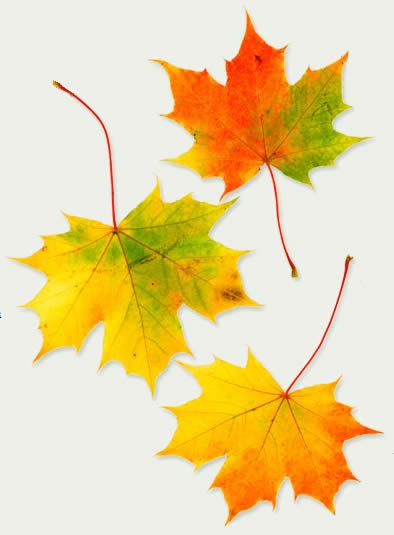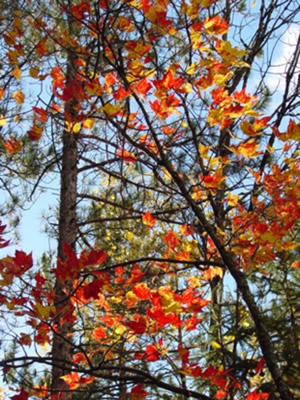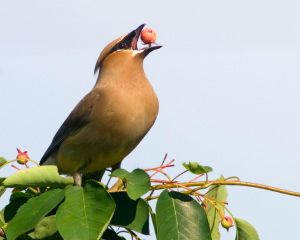A page from the "Causes of Color" exhibit...
Why are leaves and fruit different colors?

Autumn Colors
The invigorating colors that deck deciduous trees in the fall are there all year round – it’s just that chlorophyll absorbs light so strongly that less intense colors are masked. Organic pigments such as carotene and quercetin can only be seen when the chlorophyll molecules decay in the fall, and the woodlands turn red, orange, and golden brown.

As the chlorophyll in leaves decays in the autumn, the green color fades and is replaced by the oranges and reds of carotenoids.
Similarly, chlorophyll can also be damaged when leaves are cooked. The molecules denature, and the central magnesium atom is replaced by hydrogen ions. This affects the energy levels within the molecule, causing its absorbance spectrum to alter. Cooked leaves are often paler and more yellow than fresh leaves.
Chlorophyll is not a very stable compound. It is broken down in the process of photosynthesis, so it will decompose given bright sunlight and oxygen. To maintain the amount of chlorophyll in their leaves, plants have to synthesize new chlorophyll. This requires warmth and sunlight – readily available only in the summer.
Carotene is a large conjugated molecule (C40H56) found in the chloroplasts of many plants. It facilitates photosynthesis by absorbing energy and transferring it to chlorophyll molecules. It absorbs blue and blue-green light, so that on its own it appears yellow. In a leaf containing both chlorophyll and carotene, the two pigments absorb red, blue-green, and blue light, and the resulting leaf color is green. Being far more stable than chlorophyll, carotene persists when chlorophyll production is stopped by the onset of winter. As the existing chlorophyll breaks down, the subtler yellow colors of the carotene are revealed.
Preparing for winter
Chlorophyll breakdown is part of leaf senescence, the trees’ preparation for the harsh conditions of winter. As well as halting the synthesis of new chlorophyll and breaking down existing chlorophyll, trees may transfer useful nutrients such as nitrogen to their roots.
Fruit and leaves
Another class of pigments that occur in leaves is the anthocyanins, which absorb blue, blue-green, and green light. Leaves containing only anthocyanins appear red. Anthocyanins provide the scarlet, blue, and purple hues of nature. Maple leaves, red grapes, cranberries, strawberries, blueberries, plums, and red apples contain anthocyanins as part of their palette.

Unlike carotenoids and other pigments that are present year round, anthocyanins are produced in the autumn as part of the process of leaf senescence. They may signal to seed-distributing animals that the fruit is ripe, or help protect the leaf from the ravages of sun and frost while the tree extracts nutrients from the dying leaves to store in its root system.
Anthocyanins are found dissolved in cell sap, and are not attached to the cell membrane, as are carotene and chlorophyll. The acidity of the sap determines the perceived hue of the pigment, with acidic sap producing a red color and less acidic sap producing purple. Anthocyanins are formed when the sugar concentration reaches a level high enough to react with certain proteins in the cell, providing a signal that the fruit is ripe and sweet. Light is also required for this reaction, so that an apple growing with one side in the shade may be half green (on the shaded side) and half red.
|
Anthocyanins announce to the birds and animals that will eat them and distribute their seeds that these wild raspberries (black bear, left) and serviceberries (cedar waxwing, right) are ripe |
|





